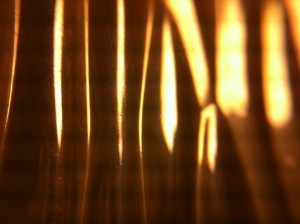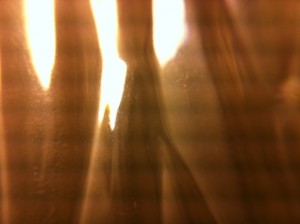Folds, Fractals and Holograms in Lurianic Kabbalah (Part 1)
By Asher Crispe: June 15, 2012: Category Inspirations, Networks of Meaning
—Inflection is the ideal genetic element of the variable curve or fold.
Giles Deleuze[1]
 Structure organizes the conceptual unity within Kabbalistic texts. Models and modes of thinking sprout parallels and systems of correspondences built from atomic ideas, molecular synthesizes, cellular tissues—all the basic ingredients of the organism of conceptual thinking joined to create a living reality.
Structure organizes the conceptual unity within Kabbalistic texts. Models and modes of thinking sprout parallels and systems of correspondences built from atomic ideas, molecular synthesizes, cellular tissues—all the basic ingredients of the organism of conceptual thinking joined to create a living reality.
While the working role of structure that serves as an indispensable provider of reflective relief—facilitating all the swinging comparisons and contrasts that energize kabbalistic exegesis—can be detected in the full historic scope of texts and traditions, the amplification of its purpose and the burden of responsibility appears to have become more pronounced in the fine wine of Lurianic innovation.
While many of the principle features of Lurianic Kabbalah can be traced to earlier sources, it is the open-ended evolution of the older characters and the drama of their interrelationships that finds an unprecedented level of high definition and complexity. The system, familiar on a general scale, invites one to encounter uncharted territory in the unexpected twists of phenomena mirrored back onto themselves with a new degree of detail. Unpacking the particulars of the multi-tiered edifices requires additional conceptual scaffolding in order to mount the challenge from the outside.
The Lurianic project, if indeed it holds together as a single project, implies more than mere cosmetic changes nor is it reducible to a quick resurfacing of a time-tested vehicle for mystical opportunity. No half-baked mosaic has been etched on the surfaces of an old property. The mechanics have been altered. Renovation has begun in the walls. New openings are created without drilling holes. The walls themselves are modulating, causing them to fold and unfold, to fracture without breaking, to clone without copying an infinite series of details superadded to individual identities as the ornaments that write the whole in the whole of writing—the holographic.[2]
We are entertaining the notion of a “complex systems theory” within Jewish mystical literature. Particular to the corpus of Lurianic writing, this newfound complexity may best be described with the aid of far reaching tools of philosophy, mathematics and physics. Courted for comparison are the theories of the fold and monad in Leibniz, Mandelbrot’s fractals and Bohm’s holographic universe and implicate order. All espouse an affinity with the structural features of the Lurianic enterprise.
Here, we are concerned primarily with the qualities of organization as opposed to the items organized. Detached from the historical context from which it emerged, our engagement of select passages of Luria’s chief expositor, R’ Chaim Vital [1543-1620], hopes to look beyond conventions of both synchronic or diachronic comparison towards the multidirectional flow of polychronic time and let the storm and waves take us where they will.
Subsumed under the brand name “Lurianic” even though this represents the parent company of a host of subsidiaries, the seminal insight of this celebrated kabbalistic renaissance—when all of its other accolades have been stripped from it and awarded to earlier inventors—may very well be a shared passion for complexity born out of relatively simple principles. Stockpiled models such as the four elements in the Great Chain of Being or the prefabricated correspondence to the four letters of the ineffable Divine name, the cosmology of four worlds, the seferiotic array of emanative powers or dimensions of reality and consciousness, represent the common inventory of an abundance of pre-Lurianic sources.
Basic types of correspondence between limbs of the body and the commandments of the Torah have become a staple of kabbalistic discourse. These comparatively simple ideas are found in the writing of R’ Chaim Vital as well, even after his conversion from pre-Lurianic to Lurianic styles [particularly during his years in the city of Safed between 1570-1572] of expounding the tenants and interpretation of Kabbalah. In his Sha’arei ha-Kedusha we find Vital engaged in straightforward soul-body-commandment associations where [in extremely loose translation]:
A state of psycho-spiritual purity may be likened to a fruit (an object of creative production which bears within it the seeds of its own reproduction––[my insertion]) which is comprised of 613 organs (essential divisions and functions of self) and connective tissues (the internal relationships that link between and network those components) [literally limbs and sinews]. These are in turn enclothed within 613 organs and connective tissues in a state of psycho-spiritual impurity that may be considered as an [obstructive] shell or peel. And the two of them together are enclothed in the 613 organs and connective tissues of the body. [Note that 613 is the number of performatives or commandments in the Torah.]
והנה נפש הטהורה שהיא הפרי כלולה מתרי”ג אברים וגידים, מתלבשת תוך תרי”ג אברים וגידין של נפש הטמאה הנקראת קליפת הפרי, ושתיהן יחד מתלבשות בתרי”ג אברים וגידים של הגוף. 3
 While the present example already boasts a significant number of levels with the connection of 613 limbs to 613 commandments, this figure can be made more manageable by either leaving it as a general statement (without breaking it down to the individual correspondence of a particular limb to a particular commandment) or else (if we were to carry the analysis forward) an extensive chart could be made and kept intelligible by having the reader focus on only one limb-commandment relationship at a time. It’s still a working system that could potentially be fully explored and elaborated.
While the present example already boasts a significant number of levels with the connection of 613 limbs to 613 commandments, this figure can be made more manageable by either leaving it as a general statement (without breaking it down to the individual correspondence of a particular limb to a particular commandment) or else (if we were to carry the analysis forward) an extensive chart could be made and kept intelligible by having the reader focus on only one limb-commandment relationship at a time. It’s still a working system that could potentially be fully explored and elaborated.
In part 2 we will introduce another Lurianic model where there is clearly no outer limit to the complexification of relationships.
[1] The Fold: Leibniz and the Baroque. P.14.
[2] This entire essay was prompted in response to the suggestion of Professor Elliot Wolfson that Lurianic Kabbalah is an “anti-system” or the “system whose complexity drives it beyond its own usefulness as a system rendering it effectively the system of the non-system.”
[3] See Sha’arei ha-Kedusha p.9
http://www.interinclusion.org/inspirations/folds-fractals-and-holograms-in-lurianic-kabbalah-part-2/














;)
;)
;)
;)
;)
;)
;)
;)
;)
;)
